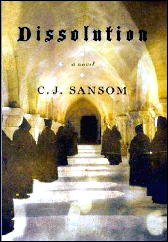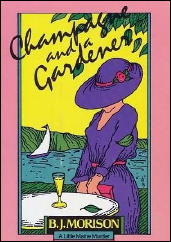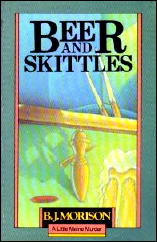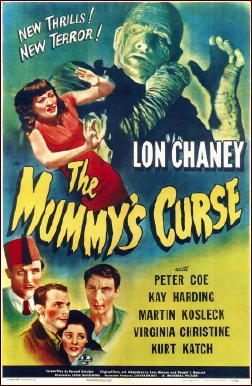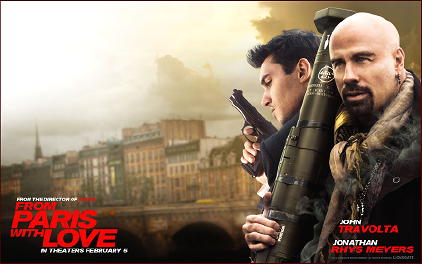June 2011
Monthly Archive
Thu 16 Jun 2011
Posted by Steve under
Reviews[19] Comments
REVIEWED BY DAN STUMPF:
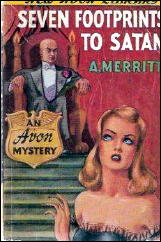
A. MERRITT – Seven Footprints to Satan. Boni & Liveright, US, hardcover, 1928. Richards, UK, hardcover, 1928. First serialized in Argosy All-Story Weekly, June-July 1927. Reprinted many times, in both hardcover and soft. Film: First National, 1929
Speaking of scary books, I recently picked up a copy of A. Merritt’s Seven Footprints to Satan. Seems to me like Merritt divided his time between creepy contemporary chillers like Burn Witch Burn and ancient-empire fantasies like Dwellers in the Mirage.
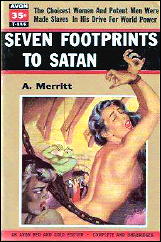
Footprints is somewhere in the middle, a fast-moving adventure with a modern (1920s) hero pitted against a criminal mastermind who styles himself as Satan, ensconced in a labyrinthine palace of preposterous proportions, staffed with mindless slaves, distressed damsels and assorted thralls.
It’s all fast-moving and purple, with chases, fights, torture… everything you pick up a thriller for. Not believable for a moment, but I didn’t put it down, either.
Wed 15 Jun 2011
REVIEWED BY WALTER ALBERT:
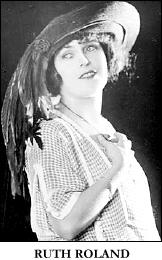
THE DEVIL’S BAIT. Balbao-General Film, 1917. Ruth Roland, William Conklin, Henry King, Ed Brady, Myrtle Reeves, Lucy Blake, Gordon Sackville. Scenario by Will M. Ritchey. Director: Harry Harvey. Shown at Cinecon 44, Hollywood CA, Aug-Sept 2008.
Another of those sentimental morality plays that I have an almost inordinate fondness for, which could be a lingering effect of my upbringing in a Southern Baptist church.
I was initially drawn to this film by the presence of Ruth Roland, a major chapter play star in the 1920s whom my mother still remembered with pleasure when I was a child. Here she was not required to exhibit any athletic prowess, but showed some skill at portraying an attractive young woman, brought up by a strict but loving father, whose checkered past almost helps bring about the downfall of his virtuous daughter, lured by an unscrupulous letch with jewels that captivate the eye and destroy the soul.
This agent of the devil is, of course, foiled and punished, but there’s some splendid melodrama along the way, with intermittent appearances by an actor clothed in a tight-fitting devil’s suit who should have spent more time working out before he took on the role.
Wed 15 Jun 2011
Posted by Steve under
Reviews[8] Comments
SUSPENSE — WITH A HITCH
Cornell Woolrich’s Rear Window and Other Stories
A Review by Curt J. Evans
CORNELL WOOLRICH – Rear Window and Other Stories. Penguin, paperback, 1994. First published as Rear Window and Four Short Novels: Ballantine, paperback original, 1984.
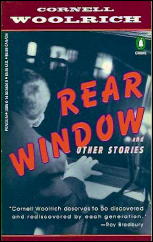
There have been so many Cornell Woolrich short story collections collected over the years that one can enter into an agonizing state of suspense just trying to decide which of these collections to buy. Fortunately I can assure you — if you do not know it already — that this particular collection is a corker.
Interestingly, not only is the title short story (“Rear Window,†1942) associated with that cinematic master of suspense, Alfred Hitchcock, so are the collection’s additional four tales: “Post-Mortem†(1940), “Three O’Clock†(1938), “Change of Murder†(1936) and “Momentum†(1940). Indeed, I strongly suspect this is why they are collected here in this volume.
Rear Window of course, is one of Hitchcock’s great films, while “Post-Mortem,†“Change of Murder†and “Momentum†all were filmed for the memorable television series Alfred Hitchcock Presents (“Change of Murder†as “the Big Switchâ€) and “Three O’Clock†was directed by Hitchcock himself for the fifties television series Suspicion.
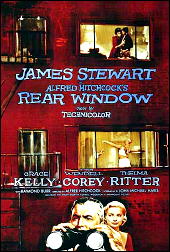
I have seen all of these adaptations bar “Three O’Clock†and all are first class mystery entertainment. (“Three O’Clock†was retitled “Four O’Clock” and shown as the first episode of Suspicion on 30 September 1957. I have never seen an episode of this series.)
Woolrich’s “Rear Window†is an excellent story, but for me it has been rather upstaged by the film. Not so the rest, however. Of the remaining four stories the most minor is the early Woolrich tale “Change of Murder,†though it a clever little piece with a nice twist in the tail (it also is the shortest of the five by far).
“Momentum†is a strong work (again with a fine twist), but my absolute favorites in this collection are “Post-Mortem†and “Three O’Clock.†Though I have great admiration for the droll television adaptation of the former (with its excellent performances by Joanna Moore, Tatum O’Neal’s mother, and Steve Forrest, a brother of Dana Andrews), I found the story easily stands on its own as a biting and ironic domestic suspense classic rather on the order of Dorothy L. Sayers’ brilliant “Suspicion.†Quite a bit of plot complexity is packed into this tale (which was streamlined in the adaptation).
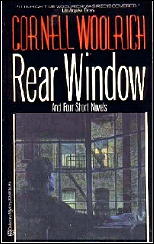
As indicated above, “Three O’Clock†was completely new to me, and I found it a powerful screw turner of tension. Again the tale has a domestic setting, but where “Post-Mortem†is black comedy, “Three O’Clock†is just blackly grim — and powerfully and memorably so.
Suspense is remorselessly (if at times improbably) drawn out and the twist, when it came, took me totally by surprise. I hesitate to say anything in detail about the plot for those who have not read the tale or seen the television adaptation. To those people: just read it!
Rear Window and Other Stories seems to me a great place to start a literary relationship with the great master of suspense Cornell Woolrich. It is also one to return to again and again … if you dare. Unpleasant dreams!
Tue 14 Jun 2011
REVIEWED BY MICHAEL SHONK:
DECLAN BURKE – Down These Green Streets — Irish Crime Writing in the 21st Century. Liberties Press, trade paperback; available for pre-order, July 28, 2011. Released in Ireland June 7, 2011.
As a daily visitor to Declan Burke’s must read website, “Crime Always Pays,” I requested and received an ARC of this book for review purposes (and because I wanted to read it).
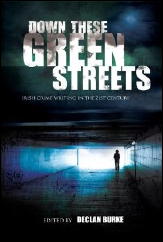
Down These Green Streets is a collection of essays, interviews, and short fiction exploring Irish crime fiction by the writers, critics, and academics involved in the genre. Aimed at the casual reader and the devoted fan, there is much for all to enjoy. This is not a book you read in one night unable to stop, though it is about such books. Instead this is a book to savor slowly, a chapter at a time.
The book begins with editor Declan Burke comments on the recent increase in the public’s interest in the Irish crime genre, followed by Michael Connelly’s Foreword, in which he discusses how American crime writers and Irish crime writers are connected.
The Introduction by Professor Ian Campbell Ross examines the role the Irish has played in history of crime fiction. Writers who share personal stories about their life, writing and the genre include John Connolly, Cormac Millar, Declan Hughes, Colin Bateman, Gerry O’Carroll, Arlene Hunt, Andrew Nugent, and Neville Thompson.
Several writers and critics did essays on various subjects: Ruth Dudley Edwards and the life and work of Liam O’Flaherty, Cora Harrison and early Irish law called the Brehon’s Laws, Adrian McKinty and North Ireland crime fiction, Alan Glynn and Irish literary crime novels, Eoin McNamee and the noir aspects of true Irish crimes, Paul Charles and characters in exile, Niamh O’Connor and the public’s interest in true crime.
More. Gerard Brennan and crime fiction after the IRA and DUP formed a government, Ingrid Black questions Irish pride, Gene Kerrigan and the appeal of crime fiction and the real misery it is based on, Sara Keating and Irish crime theatre, Brian McGilloway and the role the border between North and South plays in the genre, and Tara Brady looks at Irish crime cinema.
The book includes two interviews: John Banville by Declan Burke and Tana French with Claire Coughlan. The short stories are “Twenty-Five and Out” by Kevin McCarthy, “Inheritance by Jane Casey, “Taken Home” by Alex Barclay, “The Craftsman” by Stuart Neville, and “The Houston Room” by Ken Bruen.
In the Afterword, Fintan O’Toole discusses Irish crime fiction during the time of Raymond Chandler’s childhood in Waterford and London, and how recent changes in Ireland has given birth to the new Irish crime genre. Further Reading by Professor Ross and Shane Mawe is a short bibliography of Irish crime fiction from 1829 through 2011.
The people who are creating the new genre of Irish crime fiction are too many and too diverse to contain in just one book, but this book is the perfect beginning. The views here are as varied as the genre itself. Down These Green Streets greatest value is revealing the new Irish crime genre is as much about being Irish as it is about crime.
Here you will learn about Irish phrases such as “The Troubles” and “Celtic Tiger,” as well as the Irish meaning of the word “ride.” But you will understand more, you will realize the genre may get Americanized, but it will always have the soul of the Irish.
Tue 14 Jun 2011

ESTELLE THOMPSON – Hunter in the Dark. Walker, hardcover, first US edition, 1979; paperback, 1984. Robert Hale, UK, hardcover, 1978.
Philip Blair is blind, and his ego is deeply wounded when a young girl picked up from the bus stop where they both had been waiting is later found murdered.
With the assistance of his former fiancee, he takes it upon himself to investigate a link to the death of another small girl a short time earlier; he has a theory that he feels the police are too slow in following up on.
There seems to be a special attraction that mystery readers have toward blind detectives, and Hunter in the Dark is no exception. The story is quiet, low-key, and gently sentimental, laced with a whopping dose of coincidence, but now that Blair’s life is back on the right track, might it not be that amateur private eye work is in his blood?
Rating: B.
— Reprinted from The MYSTERY FANcier, Vol. 3, No. 6, Nov/Dec 1979 (very slightly revised). This review also appeared earlier in the Hartford Courant.
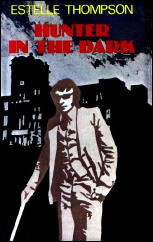
[UPDATE] 06-14-11. I wish I could say that I remember this one, but I don’t — only the title is familiar. I believe I was right, though, to say that mystery readers are fond of blind detectives, since (speaking personally) if I had this beside me right now, I’d pick it up to read again without a moment’s hesitation.
There were, alas, no other tales in which Philip Blair appeared as the detective. Of Estelle Thompson’s output of 16 crime novels between 1961 and 2000 (two of them designated by Hubin as having only marginal crime content), there isn’t a recurring series character to be found. Most were never published in the US, making her work essentially unknown in this country.
[UPDATE #2] 06-15-11. Thanks to Jamie Sturgeon for providing the cover of the British edition of Hunter in the Dark — the one you see immediately here above and to the right.
[UPDATE #3] 06-16-11. More from Jamie:
Here’s a photo of Estelle Thompson, on the back of the UK edition of The Substitute (Hale 1991). The biog on the DW states:
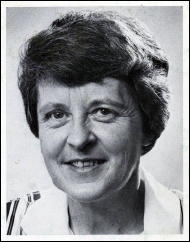
“Estelle Thompson lives with her family on a dairy farm in Nambour, Nr Brisbane, Australia. Her special interests are badminton, listening to music, omnivorous reading and animals of all kinds. She calls her writing a spare-time occupation.
“She has more than eight novels to her credit, translations of which have been published in Denmark, France, Germany, Holland, Italy, Sweden and the USA. Her first novel A Twig is Bent was serialised in Woman and on BBC radio and film rights were sold. Her fourth novel The Edge of Nowhere was serialised in Women’s Realm.”
Of course she had written more than eight novels when The Substitute was published and The Edge of Nowhere was in fact her third novel. I found on the internet a more recent Hale book (Come Home to Danger) which states on the DW more briefly that:
“Estelle Thompson has written fifteen novels. She currently lives with her brother on a farm in Queensland, Australia.”
Tue 14 Jun 2011
IT IS PURELY MY OPINION
Reviews by L. J. Roberts
C. J. SANSOM – Heartstone. Mantle, UK, hardcover, 2010. Viking, US, hardcover, January 2011.
Genre: Historical Mystery. Leading character: Matthew Shardlake; 5th in series. Setting: England; 1545.
First Sentence: The churchyard was peaceful in the summer afternoon.
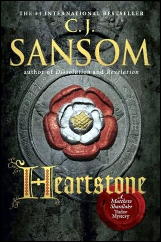
Lawyer Matthew Shardlake has been summoned to Queen Catherine Parr, last wife on Henry VIII. A former servant of hers has asked for help investigating claims by her son that his former student, Hugh Curtey, has been mistreated by Hugh’s guardian, Sir Nicholas Hobbey.
Traveling to Portsmouth with his assistant, Barak, allows Matthew to also investigate the past of Ellen Fettiplace, a young woman committed to Bedlam, but by whom?
Sansom has gifted his readers with yet another wonderful book filled with historical details. The themes of politics, greed, poverty, conscription, injustice to the less powerful and the cost of war caused by those in power on those who have no choice but must live with the consequences have been repeated through time but here are set in the middle 1500s.
One of my pleasures in reading historical mysteries is to learn. The Council of Wards was something with which I was not familiar. Most particularly, however, was learning that, but for the stubborn conviction of one woman, England might never have split from Rome.
I also wish to applaud the UK publisher, Mantle, for a physically beautiful book, from the dust cover and embossed Tudor rose on the hard cover, to the inclusion of color maps, a sewn-in bookmark and, as always, the author notes at the end. In this day of ebooks, such details are greatly appreciated.
I very much enjoy Sansom’s, and thus his character’s, voice. It has a very conversational tone which immediately drew me into the story, along with the lack of prologue. His characters are somewhat atypical in that Matthew is by no means heroic. He is an interesting, appealing character who can be stubborn, intrusive and somewhat naïve in his trust of others.
Yet he is also caring and determined in his pursuit of justice. In other words, he is human and fallible. As balance, you have his assistant, Barak, now married and about to be a father. It is nice to see how both characters, individually and in relationship to one another, have grown and developed through the series.
The plot is interesting and well done, but does get bogged down at times. There is so much history; the story itself becomes a bit lost, although certainly never to a point where I was tempted to stop reading. I was torn between feeling it would have been a much tighter, more compelling story had it been trimmed down, yet knowing I’d have learned and understood much less about the world in which the characters lived.
Sansom has taken several story lines and woven them together into a fascinating, very good whole. As ever, I am eagerly looking forward to his next book.
Rating: Very Good.
The Matthew Shardlake series —
1. Dissolution (2003)
2. Dark Fire (2004)
3. Sovereign (2006)
4. Revelation (2008)
5. Heartstone (2010)
Tue 14 Jun 2011
REVIEWED BY BARRY GARDNER:
B. J. MORISON – The Martini Effect. Elizabeth Lamb Worthington #5. North Country Press, hardcover, 1992.
Elizabeth Lamb Worthington is a precocious thirteen-year-old who lives with her grandmother in Boston when not traveling with her globetrotting parents. She has just started prep school on Mount Desert Island, Maine, after having been traumatically rejected by the school of her choice. She’s no stranger to the island, as her Grandmother has a summer home there.
There’s an interesting, not to mention weird, collection of teachers and students, and the school is still abuzz over the suspicious death by drowning last term of a student with unsavory reputation as a blackmailer. Elizabeth Lamb (use of the second name is mandatory), being nosy and having the deceased’s girl-friend as a bunkmate, finds herself investigating.
Now this is a cozy. The story gets told in a very leisurely fashion, and for quite a way into the book is more of a young-girl-at-school story than anything else. Which is not to say that it’s boring; I liked the protagonist, and I enjoyed reading about her.
Morison created an environment and set of characters that seemed real to me, though I hasten to add that the closest I’ve been to a prep school is to drive by one. Having visited the island a couple of times, I had hoped for a little more regional flavor than I found, but after all, it wasn’t meant to be a travelogue.
Against all odds, I enjoyed it; though I don’t know that I’ll be in a hurry to seek out others in the series.
— Reprinted from Ah, Sweet Mysteries #7, May 1993.
The Elizabeth Lamb Worthington series –
1. Champagne and a Gardener, 1982
2. Port and a Star Boarder, 1984
3. Beer and Skittles, 1985
4. The Voyage of the Chianti, 1987
5. The Martini Effect , 1992
Editorial Comments: Both the author and her character are new to me. Says Al Hubin in the Revised Crime Fiction IV about the author: MORISON, B(etty) J(ane), 1924-2001; born in Maine; owned and operated the Criterion Theatre in Bar Harbor, Maine.
Despite the young age of Elizabeth Lamb, the books appear to be written for adults, but I may be wrong about this. None of the other reviews I’ve found online for the series seem to say, in the same manner that Barry also did not address the issue. (The fact that all of the titles include alcoholic beverages in them may be telling us something.)
Tue 14 Jun 2011
REVIEWED BY DAN STUMPF:
â— HOUSE OF FRANKENSTEIN. Universal, 1944. Boris Karloff, Lon Chaney, John Carradine, J. Carrol Naish, Elena Verdugo, Glenn Strange, Anne Gwynne, Peter Coe, Lionel Atwill, George Zucco, Sig Ruman. Screenplay by Edward T. Lowe, from a story by Curt Siodmak. Director: Erle C. Kenton.
â— THE MUMMY’S CURSE. Universal, 1944. Lon Chaney, Peter Coe, Virginia Christine, Kay Harding, Dennis Moore, Martin Kosleck, Holmes Herbert. Director: Leslie Goodwins.
House of Frankenstein [recently reviewed here by Walter Albert] and The Mummy’s Curse were originally released on a double bill back in 1944, so I recently watched them back-to-back to get the full event-effect the artists involved must have intended.
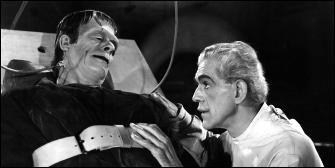
House is generally dismissed as Utter Bosh, though lots of fun, with all the old monsters (mad scientist, hunchback, Dracula, Wolfman and Frankenstein’s monster) and all the old clichés, each trotted out to strut and fret its brief fifteen minutes or so on the screen and then make way for the next: there’s the naïve young couple, suspicious burgermeister, singing gypsies, lost love, obsession, frozen-in-ice and torch-wielding villagers, all played with commendable seriousness by Boris Karloff, Lon Chaney, John Carradine, J. Carol Naish and Lionel Atwill, served up with surprising stylishness by director Earle C. Kenton.
House of Frankenstein was followed the next year by (wait for it…) House of Dracula (Universal, 1945) the sad swan song of the Monster Movie hey-day, offering the Frankenstein monster, Dracula and the Wolfman, with a Mad Scientist and distaff hunchback tossed in for good measure.
These movies are two of my guilty pleasures; I know in my head they’re ridiculous, but it thrills my heart to see all the old clichés — and I mean all of them — treated respectfully one last time.
But there’s something else lurking about House of Frankenstein, something oddly evocative about all the rapid-fire drama played out on moonlit nights: When you’re young, an October night can be a lifetime. You can make a life-long friend, get your heart broken, find God, decide on a career, and get into serious trouble, all of it terribly dramatic, because you’re young.
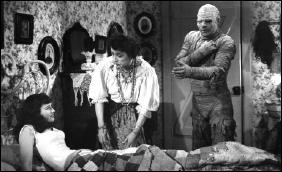
And in some delirious way, House of Frankenstein captures this adolescent self-importance and conveys it in suitably lurid tones to anyone who can still hear that faint, defiant cry of lost youth.
As for Curse, well, the Mummy movies were the proletarian working dogs of the horror film, slogging their way through a pointless world, and Curse is no exception, despite a memorable few minutes when Princess Ananka resurrects herself from the earth.
Aside from that, it’s slow, slow going, but I wonder how kids reacted to seeing Peter Coe, a hero in House of Frankenstein, here playing a satanic high priest. Coe was hyped by Universal as the new Charles Boyer, before they lost interest and shunted him into dreck like this, but I have to say he delivers lines like “May the curse of Amon-Ra be upon you,” with an admirably straight face.
Mon 13 Jun 2011
THE BACKWARD REVIEWER
William F. Deeck
VAN SILLER – The Mood for Murder. Doubleday Crime Club, hardcover, 1966. Paperback reprint: Curtis, no date [1967?].
If a mystery writer — in this case, Allan Stewart, author of Death at Dawn, among other books — can’t accept that a young lady with whom he was almost in love has discovered a body, now missing, and has been shot at, who will believe it?
As a practitioner in this field, surely Stewart knows that all such tales, particularly the most implausible, have a basis in fact and that failure to accept them inevitably leads. to unpleasantness.
Since Stewart rejects the young lady’s story, a murder by shooting occurs, with the murdered woman possibly being mistaken for the young lady who earlier claimed to be shot at, followed by a murder by threat.
All of this takes place at an exclusive Florida resort among the well-to-do and beautiful, and the mostly unpleasant. Unlikely coincidences constitute the explanation at the end.
I may try another of Hilda — if the author’s sex is of interest to anyone — Van Siller’s novels with Allan Stewart to find out if he has learned anything from his profession of mystery writer. I won’t expect to enjoy it.
— From The MYSTERY FANcier, Vol. 12, No. 3, Summer 1990.
Bibliographic Notes: (Hilda) Van Siller, 1911-1982, was the author of 21 crime fiction novels published between 1943 and 1974, most of them for Doubleday’s Crime Club imprint, but a small handful appeared only in British editions. In spite of her sizable output, among authors recently covered on this blog, I believe she qualifies as being among the Top Ten “Most Forgotten.”
The Alan Stewart series —
A Complete Stranger (n.) Doubleday, US, 1965
The Mood for Murder (n.) Doubleday, US, 1966
The Biltmore Call (n.) Ward, UK, 1967 [no US edition]
Mon 13 Jun 2011
REVIEWED BY STAN BURNS:
FROM PARIS WITH LOVE. Europa Corp., 2010. John Travolta (Charlie Wax), Jonathan Rhys Meyers (James Reece), Kasia Smutniak, Richard Durden. Bing Yin, Amber Rose Revah, Eric Godon, François Bredon. Director: Pierre Morel.
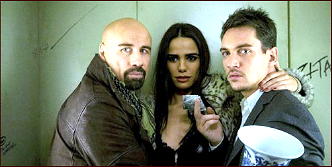
A movie from the director of Taken, a movie I really liked. In this one, low level intelligence agent James Reece (he does stuff like change the license plates on cars in parking lots) is the only person available to help top agent Charlie Wax (John Travolta with a shaved head) who has just arrived for a special operation in Paris.
Mostly Reece is a driver, and he is appalled when Wax starts killing massive numbers of people in a HK director John Woo-inspired slow motion ballet. There’s a lot of action, but the first half of the movie left me cold. Travolta, who has a great deal of charm, is a very unlikeable character in this one, and he starts killing people right from the start without our knowing the reason — is there method behind the madness, or has Travolta’s character gone psycho?
Halfway through the movie turns in another direction and becomes not just a shoot-em-up but a darker thriller — and at that point I started getting drawn in. The last half of the movie is good, and it packs a dark and surprise ending.
The movie also features a great car chase. In French movies (and even though this movie is in English, it was a French production, with a script by Luc Bresson) they drive really fast, they don’t crank the camera speed to make it look fast like they do in a lot of American TV shows. If you can get through the first half you might like this movie.
Rating: B minus.
« Previous Page — Next Page »











